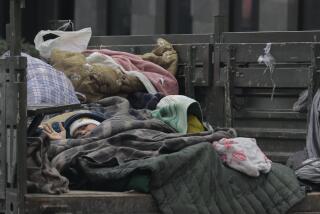Soviet Far East Islands Sitting in a Sea of Fishing and Frustration
- Share via
KUNASHIR ISLAND, THE KURILES — The empty dirt roads and weather-beaten wooden houses of Kunashir Island speak quiet volumes about the slow pace of life where the Soviet Union meets the Pacific Ocean.
Eight time zones removed from the angry hives of nationalist unrest in the Soviet western republics, relative calm prevails on the nation’s easternmost frontier--one corner of the empire that is not striking back.
Still, it gives Moscow headaches. The Soviet Far East--from the Kurile Islands, including Kunashir, north of Japan, to the heart of Siberia--has economically fallen behind the rest of the country.
A push to lure foreign investment and catch the Pacific’s powerful economic wave has enjoyed limited success. With economic failures a major ingredient of political unrest in the west, the Soviet inability to mobilize the comparatively peaceful east, to cash in on the hungry markets of its Asian neighbors, is a bitter irony.
Two years after Soviet leader Mikhail S. Gorbachev unveiled his economic hopes for the Soviet Far East in Vladivostok, the region’s share of national output is shrinking. Productivity is low; housing and health care are well below standard.
The foreign capital that was supposed to yank the region back on its feet has not yet arrived in desired quantities. Kunashir and other islands of the Sakhalin administrative district, roughly the eastern third of the Soviet Far East, illustrate why.
Most Americans last heard of Sakhalin Island, largest of the region’s 89 islands, in 1983, when Soviet fighters based on the sturgeon-shaped stretch of land shot down Korean Air’s flight 007.
Japanese occasionally hear about the Kurile Islands, hanging like a necklace from Japan’s northernmost island to the Kamchatka Peninsula in eastern Siberia, because Japan still thinks it owns four of them. Tokyo and Moscow have been tussling over what the Japanese call the “northern territories” ever since Soviet troops overran them in the closing days of World War II.
On paper, the Sakhalin region should be Japan’s fish and dairy pantry, gas station and lumber yard.
“Our water areas are very good for every kind of fish. We are rich in coal, oil and gas, paper and wood products,” the region’s governor boasted to visiting journalists in Yuzhno-Sakhalinsk, a grungy regional capital nestled among Sakhalin’s tree-clad hills.
But investors, particularly the Japanese, stay away in droves. So do foreign tourists.
The territories dispute is an obvious obstacle for Japanese executives. Tokyo refuses to sign a peace treaty--or sanction large-scale investments in the Soviet Union--pending the islands’ return.
There are rumors that Moscow has offered at least two of the islands in exchange for a fat economic investment package. Georgy A. Arbatov, one of Gorbachev’s closest advisers, said last month, however, that giving back “even one half of a small island . . . will open the whole Pandora’s box of territorial questions.”
Besides, the Kuriles are more than a bunch of water-soaked rocks. They span one of the world’s three richest fishing grounds. One army division and 40 MIG aircraft call the northern territories home, not to mention three other divisions, MIGS and ships prowling Sakhalin and the Sea of Okhotsk.
“Since Gorbachev, the Soviet Union and Japan have started to talk. But this is a process,” said Tokyo University professor Toru Kenno, adding that the process will not end any time soon.
While Japanese businessmen are not especially famous for political scruples, something else is keeping them away. “The infrastructure there is very poor,” said one businessman, who asked not to be named. The central government bled Sakhalin of its riches for centuries, starting from before 1890, when Anton Chekhov wrote a book about miserable conditions on the island, then a czarist prison camp.
Today, Moscow absorbs 30 million of the 70 million rubles Kunashir’s cannery produces annually, said an official in Yuzhno-Kurilax, the largest city--population 7,000--on the nearly deserted island. The region’s prolonged bleeding caused faulty communication, poor housing and rotten roads. A promised 10-year economic redevelopment package--200 million rubles-worth--and other reforms languish on some bureaucrat’s desk.
Subservience to central planners is another handicap. Almost two-thirds of the trees logged in the Soviet Far East rot where they fall, victims of bankrupt economic planning. Factories must ask paper-shufflers 4,200 miles away for supplies. A fish cannery in Sakhalin, short of cans this summer, had to bulldoze hundreds of rotting salmon into holes in the ground.
The region’s small 8-million-person consumer market--Sakhalin, the regional population center, accounts for less than a tenth--is another obstacle.
A bigger problem is the nonconvertible ruble. “Investors doubt that the return on investment will be enough, especially in foreign currency. To the Japanese investor, the ruble is only paper,” scoffed the Japanese businessman.
Then there is the question baffling Soviet-watchers worldwide: Will Gorbachev and his political and economic reforms survive?
Political reform arrived in Sakhalin only last year, when the region’s top party boss was sent packing by media reports of corruption.
Economic reform is a reality mostly for the sunburned Russian and Korean truck farmers on Sakhalin, freed to sell their mounds of bright red tomatoes and bunches of colorful flowers directly to customers instead of only to the state.
Soviet authorities have won a few investment agreements, including a tentative plan for a $69-million Japanese-financed pulp mill on Sakhalin. Yuzhno-Sakhalinsk officials and private entrepreneurs report nibbles from businessmen in China, North and South Korea, Vietnam and New Zealand.
Yet for now, the risk is too great, conclude most Japanese investors.
The message to Moscow is clear: Unchain the economy. Only more local power in local hands can spin the economic honey that might attract Asian investors and revitalize the Far East, meaning more good news for the rest of the nation.
With so many problems nearer the Kremlin, is anyone in Moscow listening?
More to Read
Sign up for Essential California
The most important California stories and recommendations in your inbox every morning.
You may occasionally receive promotional content from the Los Angeles Times.













